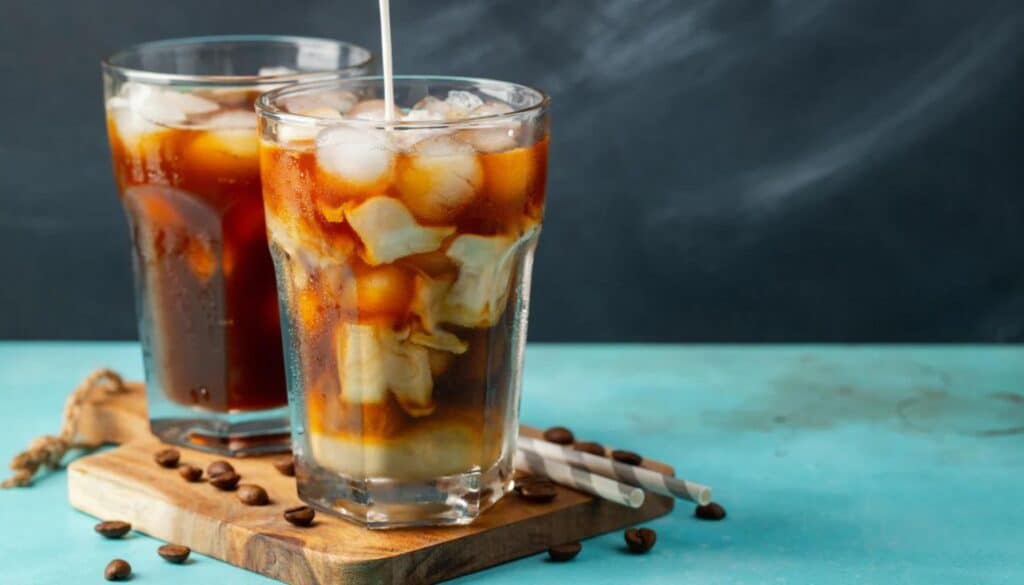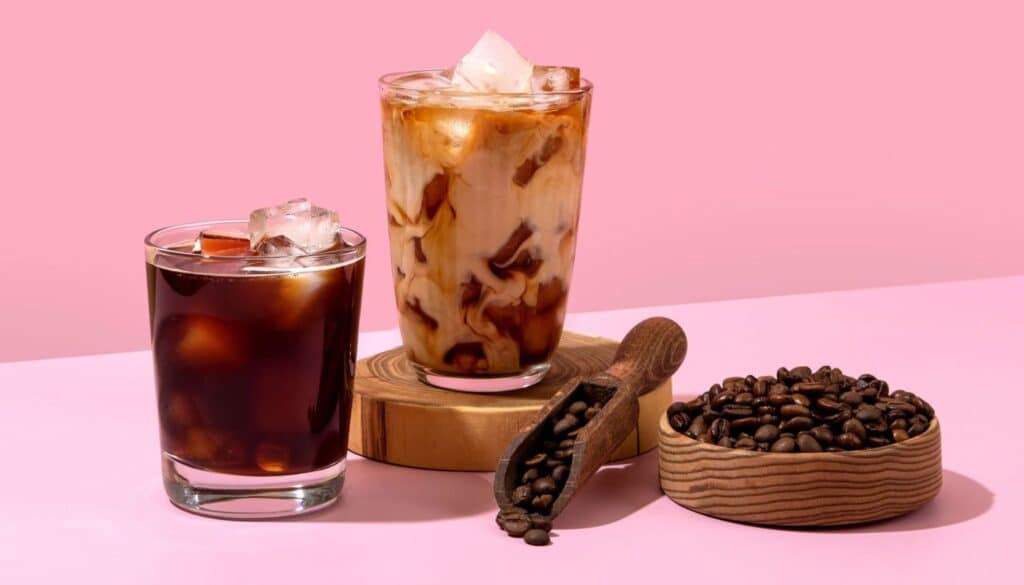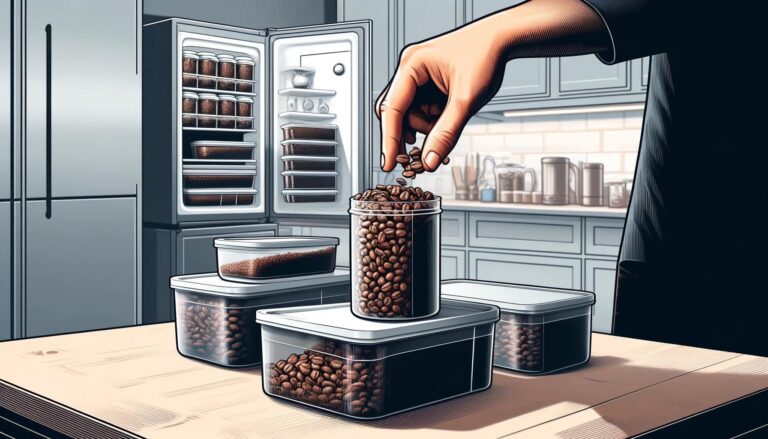People all over the world love coffee, making it a daily essential for millions. Its long history, various ways to make it, and its special place in different cultures show why it’s so popular everywhere. Lately, cold brew and iced coffee have become favorites, especially when it’s hot outside. Although both are cool twists on the usual hot coffee, they’re quite different in how you make them, how they taste, and how you serve them.
Cold brew coffee, which tastes smooth and mild, is made by soaking coffee grounds in cold water for a long time. This method makes the coffee less acidic than hot-brewed coffee, giving you a sweeter, smoother cup that’s easier on your stomach. Iced coffee, on the other hand, is just hot coffee that’s been cooled and poured over ice. It keeps a lot of the acidity and strong flavors of hot coffee.
This article aims to dig into the differences between cold brew and iced coffee, looking at how to make them, their tastes, and the best ways to enjoy each one. Knowing these differences helps coffee lovers choose the right method for their tastes and lifestyle. Whether you’re really into coffee or just someone who likes trying new things, learning about cold brew and iced coffee will make you enjoy this drink even more.
What’s The Difference Between Cold Brew and Iced Coffee?
Cold brew is made by steeping coffee grounds in cold water for 12-24 hours, resulting in a smooth, sweet, and less acidic flavor, often served diluted with water or milk. Iced coffee is brewed hot and quickly cooled down, retaining a more traditional coffee flavor that can be more acidic, and is served over ice often with added syrups or milk. While both can vary in caffeine content, cold brew typically has a higher concentration due to its brewing process and ratio of coffee to water.
Understanding Cold Brew

Definition of Cold Brew Coffee
Cold brew coffee is a method of brewing that involves steeping coffee grounds in cold or room temperature water for an extended period. Unlike traditional coffee brewing methods that rely on hot water to extract flavor and caffeine, cold brew relies on time to achieve a smooth, rich flavor profile. This method produces a concentrated coffee that can be served cold, often diluted with water or milk.
The Brewing Process
- Time Taken to Brew: The cold brew process typically takes anywhere from 12 to 24 hours, depending on the desired strength. This slow extraction time is crucial for developing the unique flavor profile of cold brew coffee.
- Temperature of Water Used: Cold or room temperature water is used in the brewing process, significantly differing from the hot water used in traditional coffee brewing methods.
- Type of Coffee Grounds Recommended: Coarse coffee grounds are preferred for cold brew. This is because finer grounds can result in an over-extracted brew and may pass through filters, causing sediment in the final drink.
Taste Profile
- Flavor Characteristics: Cold brew coffee is known for its smooth, sweet, and mild flavor. The slow extraction process reduces bitterness and enhances the natural sweetness of the coffee beans.
- Acidity Levels: Cold brew typically has lower acidity than hot-brewed coffee, making it smoother and gentler on the stomach. This is a significant advantage for those sensitive to the acidity of traditional coffee.
- Caffeine Content Comparison to Other Coffee Types: While the caffeine content can vary, cold brew coffee is often more concentrated than hot-brewed coffee. When diluted with water or milk, its caffeine content becomes similar to, or slightly higher than, that of regular coffee.
Popular Ways to Enjoy Cold Brew
Cold brew coffee is versatile and can be enjoyed in several ways, catering to a wide range of taste preferences:
- Straight Up: Enjoyed as is, over ice, for a refreshing and robust coffee experience.
- With Milk or Cream: Adding milk, cream, or a dairy alternative can soften the flavor and add a creamy texture.
- Flavored Syrups and Sweeteners: Customizing cold brew with vanilla, caramel, or simple syrup for a sweet twist.
- Coffee Cocktails: Used as a base for coffee-infused cocktails for an inventive take on traditional drinks.
The growing popularity of cold brew coffee is a testament to its unique taste and the versatility it offers coffee lovers. Whether you prefer it straight, diluted, or as a cocktail ingredient, cold brew provides a delightful and refreshing way to enjoy coffee.
Understanding Iced Coffee

Definition of Iced Coffee
Iced coffee is simply coffee that has been brewed hot and then cooled down, typically by being poured over ice or mixed with ice in a blender. It’s a refreshing way to enjoy the rich flavors of coffee with a cool twist, perfect for warmer weather or for those who prefer their caffeine cold.
The Brewing Process
- Traditional Brewing Methods: Iced coffee starts with traditionally brewed coffee, which can be made using a drip brewer, French press, espresso machine, or any other method of making hot coffee.
- Immediate Cooling Process: Once the coffee is brewed, it is immediately cooled down to halt the brewing process and preserve the flavor. This can be done by pouring the hot coffee over a cup filled with ice or placing it in the refrigerator.
- Type of Coffee Grounds Recommended: Medium to fine grounds are typically used for iced coffee, similar to those used for hot coffee, to achieve a balanced extraction.
Taste Profile
- Flavor Characteristics: Iced coffee tends to retain the robust, full-bodied flavor of hot coffee but with a refreshing coolness. The flavor can vary widely depending on the beans used, the brewing method, and the concentration of the coffee.
- How Dilution Affects Taste: The melting ice can dilute the coffee, potentially weakening its flavor and strength. To combat this, some prefer to brew the coffee stronger than usual or use ice cubes made from coffee.
- Caffeine Content Comparison to Other Coffee Types: The caffeine content in iced coffee is comparable to that of its hot counterpart, assuming the same amount of coffee grounds and water are used. However, dilution with ice can affect the perceived strength and caffeine level.
Popular Ways to Enjoy Iced Coffee
- Classic Iced Coffee: Served over ice, often with a splash of milk, cream, or sweetener to taste.
- Iced Lattes or Mochas: Combining iced coffee with steamed milk and flavorings like chocolate for a sweet, creamy treat.
- Cold Brew Iced Coffee: Though technically a different method, some people refer to cold brew coffee served over ice as iced coffee for its cold serving style.
- Flavored Iced Coffee: Adding syrups or extracts like vanilla, caramel, or hazelnut to enhance the coffee’s flavor.
Iced coffee offers a straightforward and customizable way to enjoy coffee cold. Its preparation and enjoyment can be as simple or as complex as desired, from a quick pour-over-ice method to more elaborate recipes involving syrups, milk, and flavorings. Whether you’re looking for a quick caffeine fix on a hot day or a flavorful coffee experience, iced coffee provides a versatile and satisfying option.
Key Differences Between Cold Brew and Iced Coffee

The distinctions between cold brew and iced coffee lie in their brewing techniques, flavor profiles, acidity levels, caffeine content, and optimal consumption scenarios. Understanding these differences can help coffee enthusiasts choose the right drink to suit their preferences and the occasion.
Brewing Time and Method
- Cold Brew: Involves steeping coarse coffee grounds in cold or room temperature water for 12 to 24 hours. This extended brewing time allows for a slow extraction process, which results in a concentrated coffee that is typically diluted before serving.
- Iced Coffee: Made by brewing coffee hot and quickly cooling it down, either by pouring it over ice or refrigerating. This process is much faster, taking only as long as the hot coffee brewing method chosen plus cooling time.
Flavor and Acidity
- Cold Brew: Offers a smooth, sweet, and mellow flavor with lower acidity, making it easier on the digestive system. The reduced bitterness and acidity highlight the coffee’s natural sweetness and subtle flavor nuances.
- Iced Coffee: Retains the robust, full-bodied flavor and higher acidity of hot coffee, which can be more pronounced when cooled. The immediate cooling process preserves the coffee’s original taste profile, including its acidity.
Caffeine Content
- Cold Brew: Generally has a higher caffeine concentration due to the long steeping process and the high ratio of coffee to water. However, because it’s often diluted, the final caffeine content can be similar to or slightly higher than regular coffee.
- Iced Coffee: The caffeine content is similar to that of hot coffee, assuming the same brew strength. However, dilution with melting ice can slightly lower the effective caffeine content, depending on how much ice melts and dilutes the coffee.
Best Times and Ways to Enjoy Each
- Cold Brew: Perfect for those seeking a smooth, refreshing coffee experience without the bitterness or high acidity. Its ease on the stomach and sweet profile make it ideal for any time of day, especially for slow sipping in warm weather.
- Iced Coffee: Best for those who enjoy the strong flavors and aromatics of traditional coffee but want a cooler alternative. It’s great for a quick caffeine fix or as a base for creamy, sweetened coffee drinks.
In summary, while both cold brew and iced coffee offer delightful ways to enjoy coffee cold, the choice between them depends on one’s taste preference, sensitivity to acidity, desired caffeine level, and the time available for preparation. Cold brew, with its sweet, smooth character, suits those looking for a less acidic, more nuanced coffee experience. In contrast, iced coffee appeals to those who prefer the bold flavors and convenience of hot brewed coffee, served cold.
Health Benefits and Considerations

Both cold brew and iced coffee offer health benefits associated with regular coffee consumption, including improved mental alertness, potential reduction in the risk of certain diseases, and antioxidant properties. However, there are also important considerations to keep in mind, particularly regarding caffeine intake and the addition of sugars or creams.
Health Benefits
- Mental Alertness: Both beverages contain caffeine, known to enhance mental alertness and concentration.
- Antioxidant Properties: Coffee is a significant source of antioxidants, which can protect cells from damage by free radicals.
- Reduced Risk of Certain Diseases: Studies have suggested that regular coffee consumption may be linked to a lower risk of several diseases, including Parkinson’s disease, type 2 diabetes, and certain types of cancer.
Considerations for Consumption
- Caffeine Intake:
- Cold Brew: Due to its concentration, cold brew can contain a higher amount of caffeine per serving compared to iced coffee. While caffeine has benefits, excessive intake can lead to restlessness, anxiety, heart palpitations, and may disrupt sleep patterns.
- Iced Coffee: The caffeine content is similar to hot coffee, but dilution with ice may slightly reduce its strength. It’s still important to monitor intake, especially for those sensitive to caffeine or consuming multiple servings.
- Added Sugars and Creams:
- Both cold brew and iced coffee are often consumed with added sugars, syrups, creams, or flavored milk, which can significantly increase the calorie content and reduce the health benefits.
- For a healthier option, consider using minimal sweeteners or choosing natural sugar alternatives. Opting for low-fat or plant-based milk can also help manage calorie intake.
- Acidity Considerations:
- Cold Brew: Its lower acidity compared to iced coffee and traditional hot coffee makes it a preferable choice for individuals with digestive sensitivities or acid reflux.
- Iced Coffee: The higher acidity level in iced coffee, similar to that of hot coffee, might not be suitable for everyone, especially those prone to gastrointestinal issues.
Overall Health Implications
Moderate coffee consumption, including cold brew and iced coffee, can be part of a healthy diet for most people. However, it’s essential to consider individual tolerance to caffeine and the potential impact of added sugars and fats on overall health. By making mindful choices about how coffee is consumed, individuals can enjoy these beverages’ benefits while minimizing potential downsides.
DIY Tips for Making Cold Brew and Iced Coffee at Home

Creating cold brew and iced coffee at home is simple and can be very rewarding, allowing you to customize your drink to your taste preferences. Here’s a guide to help you make these refreshing beverages with ease.
Equipment Needed
- For Cold Brew:
- A large jar or pitcher
- A fine mesh sieve or cheesecloth
- A coffee grinder (for fresh beans)
- For Iced Coffee:
- A coffee maker of choice (drip brewer, French press, etc.)
- Ice cube tray (optional, for coffee ice cubes)
- A refrigerator or a large glass for immediate serving
Cold Brew: Step-by-Step Guide
- Grind the Coffee: Coarsely grind about 1 cup of coffee beans to ensure maximum flavor extraction without over-extraction.
- Mix with Water: Combine the grounds with 4 cups of cold or room temperature water in a large jar or pitcher. Stir gently to ensure all grounds are wet.
- Steep Overnight: Cover and leave the mixture to steep at room temperature or in the refrigerator for 12-24 hours, depending on your taste preference.
- Strain: Use a fine mesh sieve lined with cheesecloth (or a coffee filter) to strain the coffee into a clean jar or pitcher. Repeat if necessary to remove all grounds.
- Serve: Dilute the concentrate with water or milk to taste, serve over ice, and enjoy!
Iced Coffee: Step-by-Step Guide
- Brew Hot Coffee: Brew your coffee stronger than usual since it will be diluted by ice. Use about 1.5 times the amount of coffee you would normally use.
- Cool It Down: Immediately transfer the hot coffee to a heat-resistant container and let it cool at room temperature for a few minutes. Then, place it in the refrigerator to cool completely, or pour it over a glass full of ice to cool it instantly.
- Serve: Add ice to a glass (use coffee ice cubes to avoid dilution for an even stronger coffee flavor), pour the cooled coffee over, and add milk or sweeteners as desired.
Tips for Achieving the Best Flavor
- Quality of Coffee: Start with high-quality, fresh coffee beans for the best flavor, whether making cold brew or iced coffee.
- Water Quality: Use filtered water if possible, as it can significantly affect the taste of your coffee.
- Coffee-to-Water Ratio: Adjust the coffee-to-water ratio according to your taste preference. For cold brew, a 1:4 coffee-to-water ratio is standard, but you can adjust for a stronger or milder brew.
- Steeping Time: For cold brew, experiment with the steeping time to find your preferred balance of flavors. Longer steeping times result in a stronger and more robust flavor.
- Serving Suggestions: Experiment with different additions to find what you enjoy most. This can include syrups, spices (like cinnamon or nutmeg), or different types of milk.
Making cold brew and iced coffee at home allows for a customizable coffee experience tailored to your preferences. With these simple steps and tips, you can enjoy a perfect cup of cold coffee anytime.
Conclusion
In this exploration of cold brew and iced coffee, we’ve navigated through their definitions, brewing processes, taste profiles, and health considerations, along with DIY tips for crafting these beloved beverages at home. The main differences lie in their brewing methods, flavor nuances, acidity levels, caffeine content, and the way they’re enjoyed across various contexts and preferences.
- Cold Brew is celebrated for its smooth, rich flavor with lower acidity, offering a sweet and mellow coffee experience that’s perfect for those sensitive to the bitter and acidic notes found in traditional coffee. Its methodical preparation demands patience but rewards with a concentrate that’s versatile and enjoyable in many forms.
- Iced Coffee shines with its immediacy and fidelity to the classic coffee taste, providing a refreshing and bold flavor that’s both familiar and invigorating. It appeals to those who favor the traditional coffee profile, served cold, with a quicker preparation method that doesn’t compromise on the coffee’s inherent characteristics.
The choice between cold brew and iced coffee often boils down to personal preference, influenced by taste, desired caffeine level, and the time one is willing to invest in preparation. Encouraging exploration and experimentation with both can lead to a deeper appreciation of coffee’s vast and varied spectrum.
Coffee, in all its forms, holds a significant place in cultures around the world. It’s not just a beverage but a medium for social interaction, a moment of solace, or a spark for creativity. The diversity in coffee preparations, from cold brew to iced coffee and beyond, reflects the rich tapestry of human culture and innovation. These variations invite us to explore and connect with different traditions, tastes, and communities.
As we conclude, remember that coffee is as much about the journey as it is about the destination. Whether you’re a devotee of cold brew, a fan of iced coffee, or somewhere in between, there’s always more to discover and enjoy. So, take this as an invitation to delve into the world of coffee, experiment with new brewing methods, and find your perfect cup. After all, coffee is not just a drink; it’s an experience, a ritual, and a beloved companion to many moments in life.
References and Further Reading
- Food & Wine. (n.d.). Cold brew vs. iced coffee: What’s the difference? Retrieved from https://www.foodandwine.com/cold-brew-vs-iced-coffee-7567073.
- Mr. Coffee. (n.d.). Iced Coffee vs. Cold Brew. Retrieved from https://www.mrcoffee.com/on/demandware.store/Sites-mrcoffee-Site/default/Content-Show?cid=Iced-Coffee-vs-Cold-Brew
- Taste of Home. (n.d.). What’s the difference between iced coffee and cold brew coffee? Retrieved from https://www.tasteofhome.com/article/whats-the-difference-between-iced-coffee-and-cold-brew-coffee/






